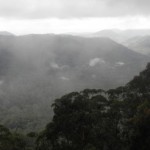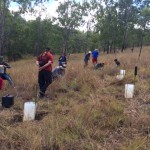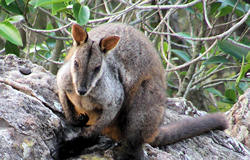Recent Event. Making Your Scenic Rim Business Wildlife-Friendly
————————————-
The Scenic Rim
The Scenic Rim is a fertile, mountainous region of southeast Queensland with high biodiversity (one of the highest in Australia).
Volcanoes erupted here more than 20 million years ago, providing basalts that weathered into nutrient-rich soil and high country that catches the rain as clouds sweep in from the Pacific Ocean. They also provided the more resistant rhyolites, now exposed in dramatic cliffs and waterfalls In the lower valleys we walk instead over rocks formed in the days of the dinosaurs.

Lamington National Park: view from Binna Burra
With such varied topography and soil, the region harbours quite a variety of vegetation types, providing habitat for a diverse array of wildlife: several kinds of rainforest and eucalyptus forests, mallee heathland, other mountain heathlands, tea-tree wetlands, mountain streams with riparian forest, swamps and other wildlife habitats.
Several important conservation areas are within its boundaries, the largest being Lamington National Park (over 20,000 hectares). Iconic species such as kangaroo, koala, platypus, kookaburra, wedge-tailed eagle and lyrebird live here as well as many lesser-known creatures, and some highly endangered ones such as the Coxen’s figparrot and the northern race of the eastern bristle bird (pictured above).
The Scenic Rim is part of the MacPherson-Macleay Overlap, a region spanning the coastal end of the Queensland-NSW border, long-recognised as a biodiversity hotspot, including a mingling of subtropical and temperate habitats where many northern species reach their southern limits and southern species their northern limits, as well as harbouring many species unique to the region.
Those of us who live in the Scenic Rim are very lucky to have such a wealth of wonderful, scenic places to explore or just relax in, and so many wildlife species living in our neighbourhood.
Our primary aims are to:
- Enhance the awareness of local residents and others of the wonderful diversity of wildlife in our region, the fascinating behaviours and ecological interactions they display, and the curious, appealing and simply beautiful and appearance of so many
- Collect and collate information relevant to conservation management
- Promote an understanding in all sections of the local community of the needs of wildlife in our region and what individuals, governments and businesses can do to ensure the survival of our wildlife well into the future.
- Present information and recommendations to relevant companies, local, state and federal governments and international bodies such as the IUCN concerning the long term conservation of wildlife and their habitats.
Our activities include:
- Public workshops on various topics – wildlife on public lands, looking for rare and cryptic (i.e. well-hidden) wildlife, particular groups of wildlife such as gliders, or conservation issues such a the proposed CSG pipeline etc.
- Wildlife Expo held in some years showcasing the diversity of our wildlife and giving locals and visitors the opportunity to see live bettongs, quolls and other native animals, wildlife artists with work-in-progress, wildlife carers, birding groups, wildlife identification, children’s activities and much more.
- Talks to schools and community groups
- Field surveys to gather data relevant to conservation management
- Meetings with politicians and others to discussion local conservation issues
- A newsletter (usually monthly) to members and other interested persons
- Outings to go walking or birding etc. as a group in scenic areas
For an overview of the wildlife found in this region, please see https://scenicrim.wildlife.org.au/the-region-its-wildlife/wildlife-of-the-scenic-rim-overview/
Major Project: Wildlife Corridors

Wildlife Corridors for the low-altitude central areas of the Scenic Rim and riparian vegetation leading down from the high country
For the past few years we’ve been attempting to establish corridors to allow small open forest mammals such as squirrel gliders and phascogales, ground-foraging birds such as fairywrens, lizards, native bees and butterflies in lowland areas, as well as fleshy-fruited native trees and other plants that provide fruits for birds of the rainforest in winter (the leanest time for fruiting n the mountain forests).
We have some wonderful national parks in our region but mostly in the higher altitude areas. There are some good wildlife “hubs” catering for the lower, drier bushland species but much open land in between, and we’re trying to fill some of he gaps. We’re also planting along gullies emanating from mountain forests, particularly catering for frugivorous birds in lean seasons and natural disasters, with fleshy fruited trees as well as general structural trees and shrubs for shelter, nesting sites etc.
We’ve been doing a lot of planting and erecting of protective fences. The grants have now ended but we will be continuing the project.
Find us on Facebook: https://www.facebook.com/Scenic.Rim.Wildlife
(Don’t confuse us with Scenic Rim Wildlife Rescue, which is doing important work on rescuing, caring for and rehabilitating injured, orphaned and displaced animals. Our own focus is on conservation and education).
Current committee: Chair Dr Ronda Green, Secretary Ms Sandy Rose, Treasurer Mr Darren Green, non-exec members Ms Nadia O’Carrol and Mr Ian Beale
| Address | Meetings and events are held at various location – see our events menu for details |
| Contact | Email us, or phone 07 5544 1283 or 0447 077725 |





